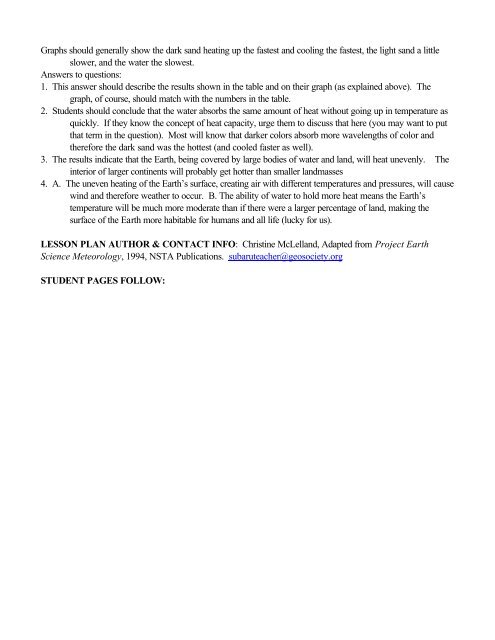Land vs. Water Temp Lab
Land vs. Water Temp Lab
Land vs. Water Temp Lab
Create successful ePaper yourself
Turn your PDF publications into a flip-book with our unique Google optimized e-Paper software.
Graphs should generally show the dark sand heating up the fastest and cooling the fastest, the light sand a little<br />
slower, and the water the slowest.<br />
Answers to questions:<br />
1. This answer should describe the results shown in the table and on their graph (as explained above). The<br />
graph, of course, should match with the numbers in the table.<br />
2. Students should conclude that the water absorbs the same amount of heat without going up in temperature as<br />
quickly. If they know the concept of heat capacity, urge them to discuss that here (you may want to put<br />
that term in the question). Most will know that darker colors absorb more wavelengths of color and<br />
therefore the dark sand was the hottest (and cooled faster as well).<br />
3. The results indicate that the Earth, being covered by large bodies of water and land, will heat unevenly. The<br />
interior of larger continents will probably get hotter than smaller landmasses<br />
4. A. The uneven heating of the Earth’s surface, creating air with different temperatures and pressures, will cause<br />
wind and therefore weather to occur. B. The ability of water to hold more heat means the Earth’s<br />
temperature will be much more moderate than if there were a larger percentage of land, making the<br />
surface of the Earth more habitable for humans and all life (lucky for us).<br />
LESSON PLAN AUTHOR & CONTACT INFO: Christine McLelland, Adapted from Project Earth<br />
Science Meteorology, 1994, NSTA Publications. subaruteacher@geosociety.org<br />
STUDENT PAGES FOLLOW:
















